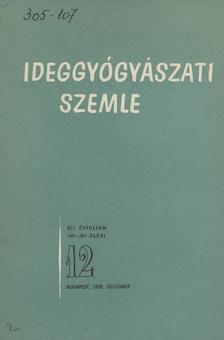The eLitMed.hu medical portal uses computer cookies for convenient operation. Detailed information can be found in the Cookie-policy.
Clinical Neuroscience - 1959;12(12)
Content
[Data on the mechanism of generation of cortical spasm potentials]
[Authors have induced seizure potentials in cat cerebral cortex by the combined use of strychnine, d-tubocurarine, and one of these agents and an eserine acetylcholine solution. The neuronal substrates of these spasm potentials were studied by surface and deep macroelectrode and microelectrode ablation. It was found that strychnine and d-tubocurarine potentials are also generated in the sleeping cortex and are not accompanied by single-cell activity. The latter is only associated with a mainly first, positive phase of these potentials in awake cortex. Eserine acetylcholine induces a rhythmic afterglow in the cortex treated with the two former agents, which is no longer localised to the upper 5-600 Y of the cortex but is detected throughout the entire depth of the cortex. Single-cell discharges are then observed in precise correlation with all surface waves. There is no rhythmic afterdischarge without single-cell activity. Authors conclude that the neuronal substrate of rhythmic aftershocks, which is very similar to the epileptic electrogram, is a vertical excitatory circuit within the cortex, in which the excitation moves from the surface to the deep and then switches back to the surface. This circuit, which also sends impulses to other brain areas and the periphery of the body, can be interrupted by the use of atropine and diphedan. The type of discharge described above is considered by the authors to be a model of discharge during an epileptic seizure, which seems to be suitable for testing antiepileptic effects. ]
Hyperkinese und Motilitätspsychose
Die Hyperkinese, d. h. rein im Psychomotorischen ablaufende Erregung, gibt noch keinen Hinweis auf eine Katatonie. Wenn es sich um eine einfache Vermehrung der Reaktiv- und Ausdrucksbewegungen handelt, dann ist im Gegenteil eine heilbare Motilitätspsychose anzunehmen. Erst, wenn Verzerrungen im Bewegungsablauf erkennbar werden, ist die Diagnose und Prognose im Sinne der Katatonie zu stellen. In akinetischen Zustenden weisen Verzerrungen der Haltung oder negativitische Züge darauf hin, dass nicht die heilbare akinetische Motilitätspsychose, sondern eine akinetische Katatonie vorliegt. Von der periodischen Katatonie sind fernehin die systematischen Formen von Katatonie mit ihren charakterischen Bildern und einem schleichenden Verlauf zu trennen.
[Clinical and pathological data on poiloencephalitis haemorrhagica superior]
[Our 43-year-old patient presented with two well-known pathologies, spinal demyelination and polioencephalitis haemorrhagica superior, due to deficiency disease and toxic damage. The co-occurrence of the two is unknown in the literature. From the clinical picture, it appears that polyoencephalopathic reactio is a relatively late complication of spinal demyelinopathy. ]
[Cerebral venous pressure testing in humans ]
[Cerebral venous pressure was measured regularly by puncture of the internal jugular vein. 1. Cerebral venous pressure varied within wide limits (19-164 mmW). 2. There was no parallel between the cerebral venous pressure and the cubital venous pressure, and the two venous systems usually behaved differently on inspiration. 3. No correlation was found between CSF pressure magnitude and cerebral venous pressure magnitude. Similarly, there was no correlation between CSF pressure and venous cubital pressure. 4 Our experiments suggest that the determination of cerebral venous pressure is necessary for experimental studies of cerebral circulation.]
[Neurological complications of malignant haematopoietic disorders]
[1.In 6.2% (19 cases) of 306 malignant haematological malignancies we observed neurological complications, 11 patients had radiculomedullary syndrome, 3 patients had disturbed consciousness, 5 patients had lesions of the cranial nerves and one patient had lesions of the sympathetic nervous system. 2. In seven cases, neurological symptoms were the initial complaint of the patient. In order to diagnose the pathology early, we call attention to histological examination of lymph nodes, skeletal radiography, serum and CSF electrophoresis, peripheral blood count, bone marrow aspirate if necessary. 3. Radiotherapy for local neurological lesions ; combined cytostatic and radiotherapy for generalised tumours or advanced leukaemias ; surgical treatment for severe spinal cord compression. ]
[Report]
[The author reports on the symposium held in Jena, Germany, October 17-19, 1959, by the Electroencephalography Society of Democratic Germany.]
1.
Clinical Neuroscience
[Headache registry in Szeged: Experiences regarding to migraine patients]2.
Clinical Neuroscience
[The new target population of stroke awareness campaign: Kindergarten students ]3.
Clinical Neuroscience
Is there any difference in mortality rates of atrial fibrillation detected before or after ischemic stroke?4.
Clinical Neuroscience
Factors influencing the level of stigma in Parkinson’s disease in western Turkey5.
Clinical Neuroscience
[The effects of demographic and clinical factors on the severity of poststroke aphasia]1.
2.
Clinical Oncology
[Pancreatic cancer: ESMO Clinical Practice Guideline for diagnosis, treatment and follow-up]3.
Clinical Oncology
[Pharmacovigilance landscape – Lessons from the past and opportunities for future]4.
5.



